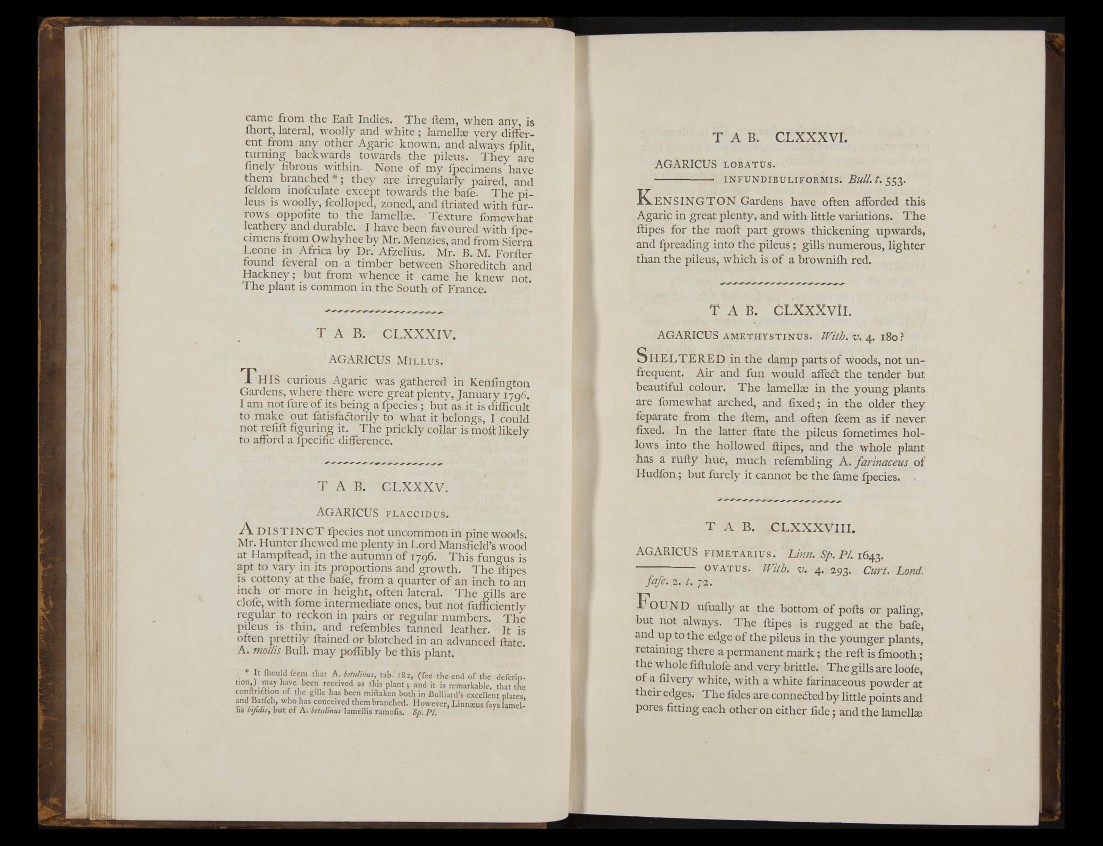
iüíiiimrtl
II ty:
i i
came from the Eaft Indies. The ilem, when any, is
lliort, lateral, woolly and white ; lamelloe very different
from any other Agaric known, and always fplit,
turnmg backAvards towards the pilens. They are
finely fibrous within. None of my fpecimens have
them branched*; they are irregularly paired, and
feldom mofculate except towards the bafe. The pileus
is woolly, fcolloped, zoned, and ilriated with furrows
oppofite to the lamellas. Texture fomewhat
leathery and durable. I have been favoured with fpecniiens
from Owhyhee by Mr. Menzies, and from Sierra
Leone m Africa by Dr. Afzelius. Mr. B. M. Forfter
found feveral on a timber between Shoreditch and
Hackney; but from whence it came he knew not.
The plant is common in the South of France.
«!I
t !
ÍM I ; •-!
<• I• I' ' i i - I
V!!
!l it i
T A B . CLXXXIV.
AGARICUS MILLUS.
I T
1 HIS curious Agaric was gathered in Kenfington
Gardens, where there were great plenty, January 1796.
I am not fure of its being a fpecies ; but as it is difiicult
to make out fatisfaftorily to what it belongs, I could
not refill: figuring it. The prickly collar is moil likely
to afford a fpecific difference.
T A B . CLXXXV.
AGARICUS FLACCIDUS.
A DISTINCT fpecies not uncommon in pine woods.
Mr. Hunter fiiewed me plenty in Lord Mansfield's wood
at Hampftea.d, in the autumn of 1796. This fungus is
apt to vary in its proportions and growth. The llipes
is cottony at the bafe, from a quarter of an inch to an
inch or more in height, often lateral. The gills are
clofe, with fome intermediate ones, but not fufficiently
regular to reckon in pairs or regular numbers. The
pileus IS thin, and refembles tanned leather. It is
often prettily ftained or blotched in an advanced ifate.
A. mo//is Bull, may poffibly be this plant.
^ * It ihould feem that A. ietulmus, tab. 182, (fee the end of the defcrintion
) may have been received as this plant ; and it is remarkable, that the
conftriftion of the g.lls has been miftaken both in Bulliard's excellent plates
has conceived them branched. However, Li.ina:us fays lamelhs
bifilis, but of A. beiulmus lamellis ramofis. Sp. PI.
T A B . CLXXXVI.
\
AGARICUS LOBATUS.
INFUNDIBULIFORMIS. 553.
KENSINGTON Gardens have often afforded this
Agaric in great plenty, and with little variations. The
ñipes for the moil part grows thickening upwards,
and fpreading into the pileus; gills numerous, lighter
than the pileus, which is of a browniñi red.
T A B . CLXXXVII.
AGARICUS AMETHYSTINUS. M/i-. V. 4. 180?
SHELTERED in the damp parts of woods, not unfrequent.
Air and fun would aíFe¿l the tender but
beautiful colour. The lamellae in the young plants
are fomewhat arched, and fixed; in the older they
feparate from the item, and often feem as if never
fixed. In the latter ftate the pileus foinetimes hollows
into the hollowed itipes, and the whole plant
has a rufty hue, much refembling A. farinaceus of
Hudfon; but furely it cannot be the fame fpecies. .
T A B . CLXXXVIII.
AGARICUS FIMETARIUS. Linn, Sp. PI. 1643.
OVATUS. With. V. 4. 293. Curt. Lond.
fafc. 2. 72.
F O U N D ufually at the bottom of polls or paling,
but not always. The ftipes is rugged at the bafe,
and up to the edge of the pileus in the younger plants,
retaining there a permanent mark; the reft is fmooth;
the whole fiftulofe and very brittle. The gills are loofe,
of a filvery white, with a white farinaceous powder at
their edges. The fides are connedled by little points and
pores fitting each other on either fide; and the lamellie